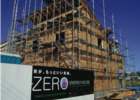Housing that responds to climate change

Conventional in appearance, but far from conventional in environmental performance — Super E homes are built to at least code level 3 of the Code for Sustainable Homes, but can easily be upgraded to code level 6.
Homes in a world of climate change will have to use little or no energy while still maintaining a stable internal environment, as Jeff Culp explains.The strict regulations imposed by the Government on the construction industry have forced the industry into a frantic search for the most economically viable method of construction that will comply with the Code for Sustainable Homes. There is a great deal of noise being made, and green washing is rife — but the truth is that the most economically viable system has been here long before the hullabaloo even started. It is a modern method of construction developed by the Government of Canada and crash tested in Canada’s extreme climate. It goes by the name of Super E. Super E building technology is based on some 50 years of building science research and 30 years of practice in Canada and has been partnering with UK contractors since 2001 to build energy-efficient and healthy housing in the UK. Super E is a an education and housing programme all rolled into one. It not only provides onsite training for its builders but also delivers keynote lectures at leading UK architectural universities, seminars at industry events such as EcoBuild as well as educating homeowners on how to live in an airtight, insulated, energy efficient home. From a construction perspective, the Super E system demands that builders construct a property so that it has low air permeability and well as high levels of insulation. A home that is not energy efficient is like a bucket losing water. You have two choices; you can either put in more water, or you can plug the holes. The Super E approach is to plug the holes. There are two key differences between a Super E home and an equivalent home of the same size — design and construction. From a design perspective, Super E allows every aspect of a new building’s energy efficiency to be considered, before it is actually built. For example, what would be the energy penalty of putting more windows into your house? Suppose it faced a different way (so the windows were facing south)? How much energy would I save if I put a little extra money into insulation or a more efficient heating system? This approach is in contrast to most housing stock in the UK — where energy efficiency is only an afterthought. Consequently, taking into the account the UK’s gas and electric ratio, a Super E home uses 41.2% less energy than an equivalent home of the same size. Research published by the Government of Canada revealed that insulated, airtight and energy efficient Super E homes are capable of maintaining a consistent indoor temperature, without any heating or air conditioning, for more than 15 hours in freezing and sweltering conditions. The results led the Canadians to the conclusion that getting the house ‘right’ is the first step before adding other environmental features, such as solar energy.

The Super E concept lends itself to developing into a home that produces as much energy as it consumes.
The research was conducted in northern Japan, where outdoor temperatures regularly drop below -4°C in the winter and reach 36 °C during the summer. The heating system in the test house was routinely turned off at 4 p.m. in the afternoon, and temperature readings taken the next day at 7 a.m. over a 10-month period. During the cold winter months, exterior temperatures fell below –14C, but the interior temperature of the Super E home remained constant. During the hot summer months the exterior temperatures reached 36°C, but the interior temperature of the Super E home still remained stable. Super E has recently brought its standard in line with the UK’s Code for Sustainable Homes and is actively seeking to contribute to revisions in the code to improve energy efficiency standards. All Super E homes are built to at least code level 3 and can be easily upgraded to level 6. This is a contrast to the vast majority of level 3 homes in the UK, which would have to be completely rebuilt to achieve level 6. Super E is competitive as you do not need a windmill on the roof to make it sustainable. Super E homes are built to be energy efficient without expensive gimmicks. However, should you wish to upgrade to code level six then it is more than feasible to include renewable technologies like solar photo-voltaics and so on. Super E is actively researching improvements in energy efficiency, and the latest addition to this endeavour is the Net Zero Home in Sapporo Japan, which produces as much energy as it consumes. This home is a continuation of the Net Zero project that was started in Canada with the aim of developing commercially viable homes to the equivalent of code level 6. The Sapporo home is the third such development by Super E and will be lived in and studied over the next few years to demonstrate Super E’s expertise at building commercially viable homes that do not contribute to global warming.
Related links:
Related articles:









